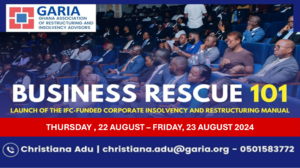By Clara Amarteifio-Taylor, PwC Partner & Licensed Insolvency Practitioner and Esther Addei, PwC Manager (Deals).
This is a summarised article of that which was published in the Maiden Edition of the national insolvency journal, Corporate Insolvency and Restructuring Journal.
In the last year, the Ghanaian economy has witnessed increased fiscal pressures and growing macroeconomic imbalances. These have negatively impacted businesses and consumers alike.
The economic slowdown can be attributed to soaring global commodity prices, global supply chain disruptions, rising global and local inflation and the depreciation of the Ghana Cedi against major trading currencies.
Further, Ghana’s public debt reached unsustainable levels with reported public debt of GHS575.7 billion representing 94.3% of GDP as at November 2022[1].
In the last quarter of 2022, the Government of Ghana (“GoG”) embarked on a program to reduce existing debt to sustainable levels through various interventions including a Domestic Debt Exchange Programme (“DDEP”). The DDEP involved a total of GHS137.3 billion of domestic notes and bonds, including E.S.L.A and Daakye bonds[2].
We note that the DDEP excluded treasury bills in totality, pension funds, notes, and bonds held by individuals (natural persons). In February 2023, the DDEP closed with 85% of the bondholders participating[3].
Further GoG was able to secure approval for an IMF Extended Credit Facility (ECF) package of USD3.0 billion which is expected to bolster recovery efforts aimed at restoring macroeconomic stability and debt sustainability.
Analysts anticipate that real GDP growth is expected to be subdued in 2023 and 2024 as short term monetary and fiscal policy stance is expected to impact domestic demand.
The macro-economic challenges are expected to affect some sectors more than others do. Most agree that perspectives on preserving value while weathering the economic storm should change including the role of restructuring of business.
How have views on restructuring changed?
Historically, restructuring was not always viewed positively by business leaders or seen as a strategic tool that can be leveraged on. The term connoted by many as a sign of failure.
However, recent global economic constraints and the evolution in consumer demands/preferences, largely driven by changes experienced during the COVID 19 pandemic, indicate that restructuring supports businesses to reinvent themselves for the new era.
Restructuring serves as an opportunity for businesses to rethink how to tackle some of the gaps in their operations which existed even prior to, and highlighted by, the current global economic trends. Restructuring when done right, is a powerful strategic tool for sustainable growth but all available options must be properly assessed prior to implementation.
In 2022, PwC as part of its annual CEO survey, engaged 4,410 CEOs across 105 countries (31 CEOs operated businesses in West Africa) on the theme “Winning Today’s Race while running Tomorrow’s”[4]. Rising inflation (81%) and economic volatility (61%) in the immediate 12 months to 5 years, were key concerns of CEOs globally.
Further, 40% of global CEOs believed that “their organisations will no longer be economically viable in ten years’ time, if they continue on their current path”.
Most CEOs indicated that it was critically important to reinvent their businesses for the future. Reinvention would include transforming how businesses currently create sustainable value for their stakeholders.
Trends Reshaping how Businesses Operate
Key trends reshaping how corporations will transform include accelerated digitisation, the growing importance of environmental, social and governance (“ESG”) goals to foster sustainability, the drive to localise operations, incorporating changing customer preferences and increasing adoption of new ways of working that promote flexibility and collaboration. These trends are pivotal in any value driven organisational restructuring.
Recent geopolitical incidents also bring with it uncertainties in how the various governments globally react in terms of imposing sanctions or bringing in new regulations that can change the commercial landscape for any organisation overnight.
An organisation can be forced to close operations in its key markets or change the sources of its inputs which can result in going concern risks. Therefore, leaders should also consider building agility to adapt quickly to changes in their organisations.
Value-based restructuring
Value-based restructuring is a model that creates a balance between cutting costs and implementing initiatives for sustainable and profitable growth[5]. This model comprises four steps as detailed below:
Understanding how your business will deliver value in the new normal
This involves assessing how value is currently being created for your customers and identifying how value will evolve in the future given changing consumer patterns. To achieve this, executives should consider each business segment or service offering, and determine the current value that is being derived.
The move to digital platforms and more flexible work options are patterns that are here to stay. Therefore, reliance on historical benchmarks should be limited and the focus should be on obtaining market data on anticipated global and local trends including potential regulatory changes. Once data has been obtained, the next step would be t o assess how future-fit operations are, and which segments/ offerings will drive cash flows and profits into the future.
With this information, businesses are positioned to put together initial strategic options for cost optimisation while identifying potential investments which will drive transformation. At this stage in the restructuring process, data collection and analytics are key to deriving insights.
Modelling different scenarios to simulate future profits at different production levels
To thrive in this new normal, flexibility must be engrained into every segment of a business. Armed with data from the work done in understanding what would deliver future value for the business the natural next step is to model different potential scenarios for each segment/ service offering. Modelling different scenarios builds agility and the ability to respond should there be a disruption in the restructuring plan.
The era of keeping static assumptions across periods is unlikely to work given that data from the International Monetary Fund[6] and World Bank Group[7] indicate declining global GDP growth rates in 2023 and potentially even to 2030.
In modelling the scenarios, it is imperative to understand the risks that may influence a segment’s performance as well as its potential impact on future cash flows. Once the risks are identified it is then important to determine available mitigants or if the risks can be adequately minimised.
Despite the size of a business or nature of goods or services produced or rendered respectively, dynamic scenario thinking is crucial in order to respond to the changing needs of customers. The various scenarios will drive the options simulation process of what the future business would look like and would support the restructure or exit decision for the various segments.
Implementing cost reduction based on the efficiency of each business segment
The finance structure of the business would need to be reassessed to ensure that costs are optimised while restructuring the business operations. The cost optimisation process can be tailored using a zero-basing approach[8]. Zero-basing means reviewing each corporate activity as if it were a new activity and then identifying the required interventions.
During the zero-basing process, costs that are critical for operations and those that are important for driving future-fit innovative goods / services should be identified. Costs that relate to nice-to-have items which are not necessary are also identified and eliminated.
During this phase of the restructuring process, it is critical that scarce resources such as time and financial investments are focused on delivering products or services that will enhance cashflow in the present or can provide value for the business in future.
It is important to note that different product and service offerings generate value at different levels and have differing future value potential. Based on this, the levels of investment for each offering should reflect the potential value to be harnessed in the future.
Evaluating all business segments and effecting the relevant changes
To truly emerge in a position of strength you will need to challenge every part of your business including the current goods and services and re-align how you innovate, produce, sell, serve and deliver. This is a hands-on exercise and should involve interaction and brainstorming across all levels from executives to front line employees.
Formal Restructuring
Effective April 2020, the Bodies Corporate Official Liquidation Act 1963, Act 180 was repealed and the Corporate Insolvency and Restructuring Act 2020, Act 1015 (“CIRA”) was passed. CIRA seeks to provide alternative formal approaches for creditors to work with corporates which would not result in the winding up.
In promoting a culture that is focused on business rescue, Act 1015 provides criteria under which a company can be restructured. Under Act 1015, a Restructuring Officer can be appointed to drive the restructuring process which includes developing a turnaround plan for the business. This provides another alternative form of restructuring.
Conclusion
Given the current global economic concerns, restructuring (financial or operational) can no longer be viewed as a sign of impending doom or defined as a solution for failing businesses.
It has become a key value preservation tool and a lever to create a sustainable future. Value-based restructuring supports businesses to be future fit given changing global dynamics. Depending on the current performance of your business, value-based transformation is a journey we encourage you to consider in these uncertain times.
For businesses that are already experiencing challenges due the current economic constraints, CIRA provides good context within which your company can explore restructuring as a means of preserving value
[1] Bank of Ghana, Summary of Economic and Financial Data, 2023
[2] Ministry of Finance Domestic Debt Exchange FAQ Issue 1 – 5 December 2022
[3] Ministry of Finance Press Release 14 February 2023 : The Government Announces Successful Results of its Domestic Debt Exchange with Approximately 85 Participation Rate and a New Settlement Date
[4] PwC, 26th Annual Global CEO Survey, Winning Today’s Race While Running Tomorrow’s, 2023
[5] Strategy&, Navigating the New Reality: Restructuring for
Growth, 2021
[6] International Monetary Fund, A Rocky Recovery, 2023
[7] The World Bank, Global Economy’s “Speed Limit” Set to Fall to Three-Decade Low, 2023
[8]Strategy&, Zero-based Cost Management: A Holistic
Approach to Managing Budgets, 2010











